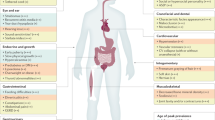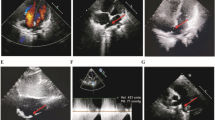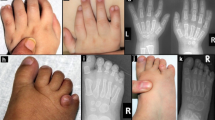Abstract
Williams syndrome (WS) is a developmental disorder affecting connective tissue and the central nervous system. A common feature of WS, supravalvular aortic stenosis, is also a distinct autosomal dominant disorder caused by mutations in the elastin gene. In this study, we identified hemizygosity at the elastin locus using genetic analyses in four familial and five sporadic cases of WS. Fluorescent in situ hybridization and quantitative Southern analyses confirmed these findings, demonstrating inherited and de novo deletions of the elastin gene. These data indicate that deletions involving one elastin allele cause WS and implicate elastin hemizygosity in the pathogenesis of the disease.
This is a preview of subscription content, access via your institution
Access options
Subscribe to this journal
Receive 12 print issues and online access
$209.00 per year
only $17.42 per issue
Buy this article
- Purchase on Springer Link
- Instant access to full article PDF
Prices may be subject to local taxes which are calculated during checkout
Similar content being viewed by others
References
Beuren, A.J. Supravalvular aortic stenosis: a complex syndrome with and without mental retardation. Birth Defects 8, 45–46 (1972).
Morris, C.A., Demsey, S.A., Leonard, C.O., Dilts, C. & Blackburn, B.L. Natural history of Williams syndrome. J. Pediatr. 113, 318–326 (1988).
Bellugi, U., Bihrle, A., Jernigan, T., Trauner, D. & Doherty, S., rophysical, neurological, and neuroanatomical profile of Williams syndrome. Am. J. med. Genet. 6, 115–125 (1990).
Dilts, C., Morris, C. & Leonard, C. Hypothesis for development of a behavioral phenotype in Williams syndrome. Am. J. med. Genet. 6, 126–131 (1990).
Chevers, N. Observations on the diseases of the orifice and valves of the aorta. Guys Hosp. Rep. 7, 387–421 (1842).
Eisenberg, R., Young, D., Jacobson, B. & Voito, A. Familial supravalvular aortic stenosis. Am J. Dis. Child. 108, 341–347 (1964).
Ewart, A.K. et al. A human vascular disorder, supravalvuar aortic stenosis, maps to chromosome 7. Proc. natn. Acad. Sci. U.S.A. 90, 3226–3230 (1993).
Curran, M.E. et al. The eiastin gene is disrupted by a translocation associated with supravalvular aortic stenosis. Cell 73, 159–168 (1993).
Morris, C., Thomas, I.T. & Greenberg, F. Williams syndrome: autosomal dominant inheritance. Am. J. med. Genet. (in the press).
Tromp, G. et al. A to G polymorphism in ELN gene. Nucl. Acids Res. 19, 4314 (1991).
Perou, M. Congenital supravalvular aortic stenosis. Arch. Pathol. 71, 113–126 (1961).
O'Connor, W. et al. Supravalvular aortic stenosis: clinical and pathologic observations in six patients. Arch. Pathol. Lab. Med. 109, 179–185 (1985).
Morris, C.A., Loker, J., Ensing, G. & Stock, A.D. Supravalvular aortic stenosis cosegregates with a familial 6;7 translocation which disrupts the elastin gene. Am. J. med. Genet. 46, 737–744 (1993).
Wahl, G.M. et al. Cosmid vectors for rapid genomic walking, restriction mapping, and gene transfer. Proc. natn. Acad. Sci. U.S.A. 84, 2160–2164 (1987).
Benton, W.D. & Davis, R.W. Screening I-gt recombinant clones by hybridization to single plaques in situ. Science 196, 180–182 (1977).
Southern, E.M. Detection of specific sequences among DNA fragments separated by gel electrophoresis. J. molec. Biol. 98, 503–517 (1975).
Curran, M.E., Landes, G.M. & Keating, M.T. Molecular cloning, characterization and genomic organization of a human cardiac potassium channel gene. Genomics 12, 729–737 (1992).
Kunkel, L.M. et al. Analysis of human Y-chromosome-specific reiterated DNA in chromosome variants. Proc. natn. Acad. Sci. U.S.A 74, 1245–1249 (1977).
Goodman, B.K., Xu, W., Nottoli, V., Rundall-Jackson, T. & Stock, A.D. A simple technique for bone marrow preparations with modified hypotonic treatment. Karyogram 11, 95–96 (1985).
Klever, M., Grond-Ginsbach, C., Scherthan, H. & Schroeder-Kurth, T.M., Chromosomal in situ hybridization after giemsa banding. Hum. Genet. 86, 484–486 (1991).
Pinkel, D. et al. Fluorescence in situ hybridization with human chromosome-specific libraries: detection of trisomy 21 and translocations of chromosome 4. Proc. natn. Acad. Sci. U.S.A. 85, 9138–9142 (1988).
Tkachuk, D. et al. Detection of bcr-abl fusion in chronic myelogeneous leukemia by in situ hybridization. Science 250, 559–562 (1990).
Fazio, M.J. et al. Human elastin gene: new evidence for localization of elastin to the long arm of chromosome 7. Am. J. hum. Genet. 48, 696–703 (1991).
O'Connell, P. et al. Twenty loci form a continuous linkage map of marker for human chromosome 2. Genomics 5, 738–745 (1989).
Vogelstein, B. et al. Allelotype of colorectal carcinomas. Science 244, 207–211 (1989).
Nakamura, Y. et al. Variable number of tandem repeat markers for human gene mapping. Science 235, 1616–1622 (1987).
Nakamura, Y. et al. A mapped set of DNA markers for human chromosome 17. Genomics 2, 302–309 (1988).
Preus, M., Williams syndrome: Objective definition and diagnosis. Clin. Genet. 24, 433–438 (1984).
Author information
Authors and Affiliations
Rights and permissions
About this article
Cite this article
Ewart, A., Morris, C., Atkinson, D. et al. Hemizygosity at the elastin locus in a developmental disorder, Williams syndrome. Nat Genet 5, 11–16 (1993). https://doi.org/10.1038/ng0993-11
Received:
Accepted:
Issue Date:
DOI: https://doi.org/10.1038/ng0993-11
This article is cited by
-
Early maturation and hyperexcitability is a shared phenotype of cortical neurons derived from different ASD-associated mutations
Translational Psychiatry (2023)
-
Genetic causes of neonatal and infantile hypercalcaemia
Pediatric Nephrology (2022)
-
Integration of genetic, transcriptomic, and clinical data provides insight into 16p11.2 and 22q11.2 CNV genes
Genome Medicine (2021)
-
Elastic tissue disruption is a major pathogenic factor to human vascular disease
Molecular Biology Reports (2021)
-
Buspirone for the Treatment of Generalized Anxiety Disorder in Williams Syndrome: A Case Series
Journal of Autism and Developmental Disorders (2020)



